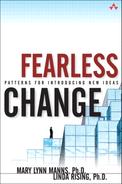Plant the Seeds
When I give a presentation, I always have a stack of publications on the topic, both for reference during the talk and for perusing at breaks and after the presentation. People like looking at them. One participant said, “Some of my happiest times have been spent with books.”
To spark interest, carry materials (seeds) and display (plant) them when the opportunity arises.
![]()
You are an Evangelist(144) or Dedicated Champion(129) working to introduce a new idea into your organization. You have some printed materials about the idea.
You want to spark some interest in the new idea.
People like to keep up on the latest buzzword and will be drawn to sources of information, especially if the sources are easily accessible. When they are in the early stages of making a decision about a new idea, they are persuaded by mass media materials, such as articles and books.
The rule of reciprocity holds across cultures. We feel an obligation to repay others when they have given us a gift. Charities rely on reciprocity to help them raise funds. For years, the Disabled American Veterans organization, using only a well-crafted fundraising letter, reported an 18% response rate to its appeals, but when they started enclosing a small gift, the response rate doubled to 35%. The gift, personalized address labels, was modest, but it wasn’t what the donors received that made the difference. It was that they had received anything at all. The articles and books you bring to a meeting may not seem like much, but those who take a copy of an article or borrow a book will be positively influenced toward you and your idea.
Therefore:
Carry materials about the new idea to events where people gather. Put them in places where people are likely to pick them up and look at them.
When you give a presentation or attend a meeting, provide sources of External Validation(148), such as books, journal articles, and online articles. Make copies of online materials rather than simply providing the URL, so that it is more likely people will see the information you think is important. If you want to point out some interesting things on the Web, make the URLs available electronically to save the recipient the trouble of typing them. Prominently display anything that has your name as author, or acknowledged contributor, to increase your credibility.
If possible, don’t just place the materials on a table and walk away. Make yourself available to answer questions. This will also help ensure that valuable things, like your books, won’t disappear!
If you are scheduled to give a presentation during the event, refer to the materials to spark even more interest. The books or articles will attract attention and get conversation going during breaks.
When people ask to take or borrow the materials, stop by your office later, or send an e-mail asking for more information, use Personal Touch(198) and Just Enough(180) to show how the new idea may be useful to them. Don’t be discouraged if most people simply stack any handouts you provide in their office and never look at them. People like to pick up free material; however, only some will read them and become interested in the new idea. But don’t underestimate the power of this pattern. Although the “seeds” usually spark interest in only a few, they may be key individuals, such as Connectors(119), Early Adopters(138), or a Guru on Your Side(158) who can help you spread the word to others.
= = = = = = = = =
This pattern creates awareness of a new idea and sparks some interest in it. People will be drawn to the materials, pick them up, and ask about them.
Carrying a lot of books or articles can be a problem on a plane. Even in a car, you might have to make several trips to the parking lot or get help unloading material. If books are displayed, you run the risk that someone could borrow one and not return it. Make sure your name clearly appears on all your valuable materials.
Alan takes patterns books to every object technology or Unified Modeling Language (UML) training course he delivers. The books always generate a lot of interest. In fact, he’s learned only to bring them out on the last day, or he risks losing the attention of the participants for the topic at hand. Most often, if consultancy follows, it’s on patterns, not object technology or UML.
Karl reports good experiences when he brings drafts of unpublished books to training sessions. It shows his audience that the topic is still evolving and interesting and ensures that he is a source of information about what’s going on, so they are getting the latest information.
